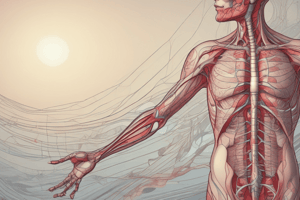Podcast
Questions and Answers
What is the main artery that carries blood away from the heart?
What is the main artery that carries blood away from the heart?
- Pulmonary Valve
- Superior Vena Cava
- Aorta (correct)
- Pulmonary Trunk
What is the name of the artery that carries blood from the heart to the left lung?
What is the name of the artery that carries blood from the heart to the left lung?
Left Pulmonary Artery
What does the Superior Vena Cava do?
What does the Superior Vena Cava do?
It carries deoxygenated blood from the upper body to the heart.
What is the function of the Right Pulmonary Artery?
What is the function of the Right Pulmonary Artery?
What is the Pulmonary Trunk?
What is the Pulmonary Trunk?
What is the name of the chamber that receives deoxygenated blood from the body?
What is the name of the chamber that receives deoxygenated blood from the body?
What is the role of the Right Pulmonary Veins?
What is the role of the Right Pulmonary Veins?
What chamber of the heart receives oxygenated blood from the lungs?
What chamber of the heart receives oxygenated blood from the lungs?
What do the Left Pulmonary Veins do?
What do the Left Pulmonary Veins do?
What is the Bicuspid Valve also known as?
What is the Bicuspid Valve also known as?
What is the function of the Tricuspid Valve?
What is the function of the Tricuspid Valve?
What does the Inferior Vena Cava do?
What does the Inferior Vena Cava do?
What is the purpose of the Aortic Valve?
What is the purpose of the Aortic Valve?
What does the Pulmonary Valve do?
What does the Pulmonary Valve do?
What are Trabeculae Carneae?
What are Trabeculae Carneae?
What does the Right Ventricle do?
What does the Right Ventricle do?
What is the function of the Chordae Tendineae?
What is the function of the Chordae Tendineae?
What is the role of the Papillary Muscle?
What is the role of the Papillary Muscle?
What is the function of the Left Ventricle?
What is the function of the Left Ventricle?
What does the Interventricular Septum do?
What does the Interventricular Septum do?
What is the Fossa Ovalis?
What is the Fossa Ovalis?
What is the Endocardium?
What is the Endocardium?
What is the Myocardium?
What is the Myocardium?
What is the Pericardium?
What is the Pericardium?
Flashcards are hidden until you start studying
Study Notes
Aorta
- Largest artery in the body, originating from the left ventricle and distributing oxygenated blood to the body.
Left Pulmonary Artery
- Carries deoxygenated blood from the right ventricle to the left lung for oxygenation.
Superior Vena Cava
- Major vein that collects deoxygenated blood from the upper body and empties into the right atrium.
Right Pulmonary Artery
- Transports deoxygenated blood from the right ventricle to the right lung for oxygenation.
Pulmonary Trunk
- Major vessel that splits into the left and right pulmonary arteries, carrying deoxygenated blood from the right ventricle.
Right Atrium
- Receives deoxygenated blood from the body through the superior and inferior vena cavae.
Right Pulmonary Veins
- Four veins that transport oxygenated blood from the right lung to the left atrium.
Left Atrium
- Collects oxygenated blood from the lungs via the pulmonary veins and pumps it into the left ventricle.
Left Pulmonary Veins
- Four veins delivering oxygenated blood from the left lung to the left atrium.
Bicuspid Valve
- Also known as the mitral valve, it allows blood flow from the left atrium to the left ventricle, preventing backflow.
Tricuspid Valve
- Regulates blood flow from the right atrium to the right ventricle, preventing backflow into the atrium during ventricular contraction.
Inferior Vena Cava
- Major vein that returns deoxygenated blood from the lower body to the right atrium.
Aortic Valve
- A valve located between the left ventricle and the aorta, it ensures one-way blood flow into the aorta.
Pulmonary Valve
- Located between the right ventricle and the pulmonary trunk, it allows blood to flow into the pulmonary arteries.
Trabeculae Carneae
- Muscular ridges on the inner surface of the ventricles that help prevent suction during contraction.
Right Ventricle
- Pumps deoxygenated blood to the lungs through the pulmonary trunk.
Chordae Tendineae
- Tendinous cords that connect the papillary muscles to the valve leaflets, preventing inversion during ventricular contraction.
Papillary Muscle
- Muscle that anchors the chordae tendineae and helps maintain valve closure during heart contractions.
Left Ventricle
- The most muscular chamber of the heart, it pumps oxygenated blood to the systemic circulation via the aorta.
Interventricular Septum
- The thick muscular wall separating the left and right ventricles of the heart.
Fossa Ovalis
- A depression in the interatrial septum, remnant of the foramen ovale, allowing blood flow between the atria in fetal development.
Endocardium
- The innermost layer of the heart wall, providing a smooth lining for the heart chambers.
Myocardium
- The thick muscular layer of the heart responsible for contracting and pumping blood.
Pericardium
- A double-walled sac encasing the heart, consisting of:
- Fibrous Pericardium: Outer layer providing protection and anchoring the heart.
- Serous Pericardium: Inner layer, consisting of:
- Parietal Layer: Lining the fibrous pericardium,
- Visceral Layer (Epicardium): Adheres to the heart surface.
Studying That Suits You
Use AI to generate personalized quizzes and flashcards to suit your learning preferences.




